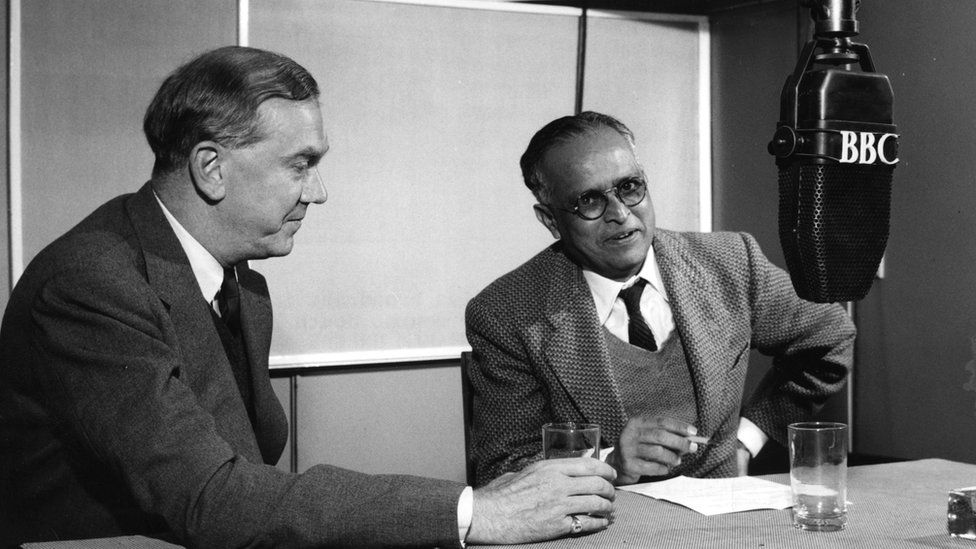RK Narayan: Restoring the home of one of India's most beloved writers
- Published

The home of one of India's most beloved English-language authors RK Narayan is set to be restored by local authorities. From what is now a dilapidated shell in Mysore, Himanshu Bhagat tells the story of the battle over the future of the property.
Fans of RK Narayan will be familiar with the charms of the South Indian fictional town of Malgudi - his most lasting creation. But those looking for his house in Mysore, the town where he lived, have spoken or written about encountering locals who had little idea of where it was or even who he was.
Narayan, whose full name was Rasipuram Krishnaswami Iyer Narayanaswami, wrote in his autobiography, My Days, how he decided to build the house after his landlord kept badgering him to vacate the rented home he had lived in for many years.
At the time he was buying the house, Narayan was also bringing out a literary magazine called Indian Thought and he admits to buying some time from the young landlord by publishing "a rather bad short story" he wrote.
It is from here that an affectionate vision of southern Indian daily life spread to the rest of the world. But if you are expecting to see a real-life slice of Malgudi, you will be disappointed once you actually get to the place.
The leafy street leading to the house - in the upper-middle class area of Yadavagiri - makes for a pleasant drive, but the sight that greets you upon arrival is a half-demolished shell.
The only occupants are a couple of caretakers, and a large dog with a mournful face that could well be the ghost of Sheba, Narayan's pet Great Dane, who features in the author's autobiography.
Work on the house commenced in 1948 and, after problems involving a crooked contractor who Narayan had to eventually take to court, it was ready five years later.
But he did not move in right away. "I kept my Yadavagiri house as a retreat for writing," he recalls in My Days. "I divided my time between Laxmipuram and Yadavagiri, enjoying the company of the family in one and of my books and papers in the other."
Narayan's study, which he described as "a bay-room with eight windows affording me a view in every direction", lies on the upper floor and is now littered with rubble.
Like the rest of the house, the doorframes and other fixtures have been wrenched free, revealing the walls' red brickwork. It would now take a writer's imagination as developed as Narayan's to picture him in this space.
"He built the house for the love of the place," Narayan's granddaughter Bhuvaneswari, who inherited the house along with her brother, told the BBC.
"He shared the house with his elder brother RK Pattabhi and his family. His mother - my great grandmother - also lived there until her death in the late 1970s."
Bhuvaneswari has happy memories of visiting the house as a child during her summer holidays. "For us he was grandfather. He was a simple man," she said. "There would be visitors, sometimes quite a few, but other than that he led a quiet life."
Narayan continued to live in the house until the early 1990s when poor health forced him to move to Chennai with his daughter.
Some years after his death, his grandchildren, neither of whom lived in Mysore, decided to tear down the house and redevelop it.
In 2011, they engaged a developer who had begun to knock down the house when a Mysore daily started a campaign to save it. In September of the same year, the Mysore Urban Development Authority declared the property a heritage building and halted the demolition.
The ensuing years witnessed more twists and turns, including protests by some local writers who asked why the Karnataka state government was preparing to spend large sums of money in memory of a writer who did not write in the Kannada language?
The government finally purchased the property for 24m rupees ($368,324; £240,152) and another 3.45m rupees was earmarked for its restoration.
"We are happy that the house is being retained the way it is, provided something is done," Bhuvaneswari said.
Work began at the site earlier this month and the authorities said it would be completed in three months.
'Restore not renovate'
Commissioner of the Mysore City Corporation CG Betsurmath told the BBC that the restored house would be turned into a museum, along the lines of Shakespeare's house at Stratford-upon-Avon in England, which attracts tourists from all over the world.
Conservation architect and self-confessed fan of Narayan, Rajnish Wattas, says the need is to "restore" - not "renovate" - Narayan's house.
The need now was to ensure that the look and ambience of the house, including details such as the furniture, should be the same as when Narayan lived there, he added.
Mr Betsurmath said the plan was to "conserve the house as it was".
For that, he added, "We have appealed through the media for people to donate works and belongings of Narayan that they have."
- Published13 May 2001